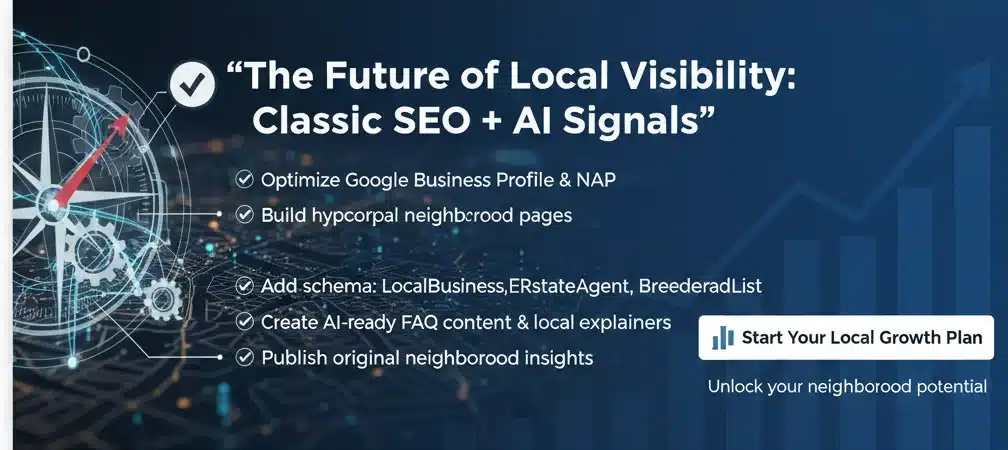Best Real Estate Website Development Agency Near Me: A Complete Guide
If you have ever typed Best Real Estate Website Development Agency into a search bar, you already know the result pages are crowded with promises, portfolios, and pricing snippets. Choosing the right partner is not a cosmetic decision. Your website will become your most visible sales asset, your 24×7 listing showroom, and your lead generation engine. This complete guide shows you how to evaluate agencies near you and beyond, what features actually move the needle for property businesses, how to future proof your stack for AI-First Search, and why a disciplined delivery partner like Depex Technologies can cut time to value while improving conversion.
Why real estate needs specialized web development
Real estate is not a typical brochure industry. Properties change daily. Inventory must sync with MLS or a custom listing feed. Buyers expect map search with precise filters. Sellers expect valuation pages and instant callbacks. Agents need a CRM that auto logs every form submission. Search engines and AI assistants must understand your areas served, property types, and local expertise. In other words, the stack is dynamic, data heavy, and conversion sensitive. A generalist vendor may ship something that looks fine, yet it will underperform when measured on traffic quality, lead capture, and pipeline value.
A specialized team builds with these realities in mind. They design catalog structures for neighborhoods, school districts, and micro markets. The implement IDX and MLS feeds correctly, with schema that helps search engines connect listings to geo coordinates. They test real world journeys on mobile data, since a large percentage of property discovery begins on phones during commutes or open house weekends. Most important, they know how to keep the site fast even as image heavy listings multiply.
Core outcomes your site must deliver
Before you compare checklists, decide what success looks like. Real estate sites exist to do three things well. First, they attract the right traffic through high intent keywords, local discovery, and AI-First Search. Second, they convert visitors into qualified inquiries by removing friction and offering instant communication. Third, they support operations by syncing listings, agents, and leads into the systems your team already uses.
When an agency speaks in these outcome terms, you have a strong signal. They should connect features to measurable KPIs such as organic sessions from neighborhood pages, map search engagement, lead form submissions, scheduled showings, and days to publish a new listing.
MLS and IDX done correctly
If you work with MLS data, an IDX or RESO compliant integration is vital. The implementation should handle authentication, data refresh schedules, and field mapping for property attributes like beds, baths, square footage, amenities, and geo coordinates. It should respect licensing rules for photo usage and disclaimer placement. It should also support de-duplication if multiple feeds overlap.
An effective IDX layer also supports filterable search with facets that match how people shop. Think price bands, neighborhoods, school zones, commute times, waterfront proximity, pet policies for rentals, and new construction flags. Advanced search should work instantly without full page reloads. For performance, the result grid can use static generation paired with incremental updates, or server side rendering with efficient caching. Either way, the user never waits.
Map search that actually drives engagement
Buyers rarely search by city only. They search by vibe, block, and boundary. A high converting site brings the map forward. It clusters markers, renders listing cards on the side, and keeps filters visible without obscuring the map. And It lets visitors drag to a new area and instantly see fresh results. It saves searches and subscribes users to alerts with one click. Because attention is earned in seconds, all of these actions must feel effortless on mobile.
Design details matter. Photos must thumbnail crisply. Bed and bath counts should be obvious. Price per square foot should be available, not hidden. When a user clicks a marker, the listing card appears without jank. When a user shares a link, the map position and filters persist so the recipient sees the same view. These are the touches a specialized real estate website development agency bakes in by default.
Lead capture without friction
Every website can collect a form. Not every website makes people want to submit one. Real estate lead capture improves when you remove friction, offer real value, and respond instantly. Gated saved searches, downloadable neighborhood guides, one tap WhatsApp or SMS, and instant book a viewing tools consistently outperform generic forms. Timely follow through closes the loop. Your CRM should assign leads to the right agent, trigger nurturing sequences, and allow quick replies from mobile.
A strong agency will set up progressive profiling so repeat visitors do not face the same long forms. They will connect chat and callback widgets to working workflows. They will also implement event tracking so you can measure which sources and pages turn into conversations and showings.
Local SEO and AI-First Search
Organic traffic still drives the highest ROI, and AI-First Search is reshaping how people discover local businesses. To win, you need conventional local SEO foundations and new AI friendly signals. On the classic side, you should own your Google Business Profile, maintain consistent NAP across directories, and build pages for neighborhoods, micro markets, and property types. Each page should carry structured data such as Organization, RealEstateAgent or LocalBusiness, and BreadcrumbList so crawlers understand relationships.

On the AI-First side, answer forward formats are crucial. Create concise explainers that respond to questions buyers and sellers ask, such as how to win a bidding war in your city, how transfer taxes work, how long closings take, and how to read HOA documents. Mark up these answers with FAQPage schema when appropriate. Publish original neighborhood snapshots that mention landmarks, transit lines, and school feeder patterns. Maintain a lexicon of local terms that AI models can map to your service area.
The Best Real Estate Website Development Agency near you will propose a combined SEO and AEO plan that includes page templates, internal linking maps, knowledge graph friendly schema, and editorial cadences that feed your publishing pipeline.
Performance, UX, and accessibility
Speed correlates with conversion. For image heavy property sites, this is non negotiable. Your stack should support image optimization, lazy loading, and responsive formats. Scripts must be minimal. A good rule is to load only what the user needs for the current view. Accessibility is also essential. Color contrast, keyboard navigation, focus order, and alt text for property photos improve both usability and compliance. In practice, accessibility improvements help everyone. When forms read clearly and buttons are correctly labeled, more people convert.
A thoughtful UX also reduces the cognitive load of comparing listings. Present critical data above the fold. Group photos by room type on detail pages so users can jump to kitchen, living room, or floor plans. Provide a mortgage estimate that feels trustworthy, not gimmicky. Let users favorite properties without account creation, then prompt a light login when they want to save across devices.
Content management that agents will actually use
Your site lives or dies by how fast agents can publish new listings, add open houses, and update bios. A flexible CMS allows non technical staff to create neighborhood pages, embed 3D tours, and add testimonials. It supports custom fields for MLS IDs, video URLs, and downloadable disclosures. It also safeguards layout and branding so consistency does not depend on one designer. If you are evaluating platforms, ask the agency to walk an agent through posting a new listing during discovery. If the process feels clunky, you will face resistance during adoption.
Integrations that keep operations smooth
Real estate operations run on CRMs, marketing automation, e-sign tools, showing schedulers, and analytics. A serious agency treats integrations as part of the core scope, not as a later phase. Your website should push and pull the right data with the least manual work. When a new lead submits a viewing request, the CRM should log it, assign it, and trigger a follow up. When an agent updates a phone number in the CRM, the website directory should reflect it. For seller experience, your listing intake forms can feed staging checklists and disclosure packets automatically. These little efficiencies compound.
Security, compliance, and data governance
Property sites hold personal data. Phone numbers, emails, and in some markets even financial prequalification information pass through your forms. The Best Real Estate Website Development Agency will design with secure coding practices, input validation, and encryption at rest where needed. They will implement role based access for agents and staff, maintain audit logs, and set up a structured backup strategy. For markets subject to local privacy rules, they will help configure consent management and data retention policies that align with regulation.

How to evaluate agencies with a simple scorecard
It helps to score your options using the same lens. During your RFP, ask for a small but representative demo: a neighborhood page, a listing detail page with map and nearby amenities, and a lead form that posts to a demo CRM. Then review each agency across these criteria:
- Real estate fluency. Do they speak the language of MLS, IDX, and local SEO without hand waving.
- UX and speed. Do prototypes feel immediate on mobile data.
- Data handling. How do they map listing attributes and handle feed refreshes.
- Content tooling. Can staff publish without developer assistance.
- Integrations. What CRM, chat, showing, and analytics integrations are native in their plan.
- Governance. What is the approach to security, backups, and access control.
- Delivery discipline. Are milestones, reviews, and acceptance criteria clear.
- Post launch growth. Do they provide ongoing SEO, content, and CRO improvements.
When agencies present proposals in these terms, comparisons become objective. You can select the team most likely to deliver measurable impact rather than the shiniest mockup.
Timelines and what to expect at each stage
A solid project does not have to drag. A typical timeline looks like this. Discovery clarifies goals, personas, content inventory, and technical constraints. Design explores information architecture, listing templates, map search flows, and brand elements. Build sets up the CMS, IDX integration, and page components while content migration begins. Quality assurance covers accessibility, performance, cross browser rendering, and integrations. Launch includes a soft rollout to a subset of users, analytics validation, and post launch support. Growth blends SEO publishing cadences with conversion experiments such as testing the placement of schedule a tour buttons and adjusting lead routing rules.
Each phase should finish with concrete evidence. By the end of discovery, you should own a sitemap, a feature list with acceptance criteria, and an integration plan. and By the end of design, you should hold clickable prototypes. By the end of build, your staging site should ingest real or representative listing data. Discipline like this protects your budget and keeps everyone aligned.
Content that wins in competitive markets
In crowded property markets, the site that publishes the most helpful local content wins. Start with evergreen guides that become reference pages. For buyers, write clear explainers on mortgage types, earnest money, closing costs, and inspection tips. And for sellers, write transparent breakdowns of pricing strategy, staging decisions, and listing photography. For investors, publish cash flow models and neighborhood cap rate comparisons. For relocators, publish commute tables, transit access, and school zoning maps. Use plain language and answer the question completely. Search engines and AI assistants reward clarity. Readers reward honesty.
Add storytelling too. Showcase success stories where your team helped buyers win in multiple offer situations, or helped sellers prepare a condo so well that it sold above asking in a week. Testimonials gain power when paired with concrete outcomes and vivid detail.
Measuring success after launch
A launch is the starting line. Decide on your KPIs early and track them continuously. You can include organic traffic growth on neighborhood pages, time on listing pages, map interactions per session, leads by source, booked viewings per week, and conversion from lead to client. Tie revenue back to campaigns and content that originated the relationship. Share these numbers with your agents so they understand what works and what needs focus. Continuous improvement then becomes a habit, not a scramble.
Common mistakes to avoid
Several patterns hold teams back. The first is treating IDX as a plugin you install at the end. You should design your information architecture and search experience around the feed from day one. The second is over designing homepages while neglecting listing pages and neighborhood hubs where users spend most of their time. The third is ignoring site performance in pursuit of effects. Fancy transitions do not convert if pages feel slow. A final mistake is waiting for perfection before publishing. A steady cadence of good neighborhood pages with crisp listings and honest photos beats a delayed big reveal every time.
What budget ranges look like
Budgets vary by scope, yet you can plan sensibly. A streamlined brokerage site with IDX, map search, a handful of neighborhood pages, a CRM integration, and strong design will sit in one range. A multi city site with complex feed consolidation, custom agent portals, advanced analytics, and ongoing content production will sit in a higher range. When agencies provide pricing, look beyond the number to the value story. Are you getting experienced real estate designers, engineers who have shipped map search before, content strategists who know local SEO, and a project team that communicates clearly. If yes, you are buying outcomes, not hours.
Why Depex Technologies is a strong choice
Depex Technologies designs and builds real estate sites to be fast, findable, and conversion focused. Our approach starts with measurable goals. We map every feature to an expected impact. and we design listing detail pages that load quickly and highlight the elements buyers care about. And we also implement IDX with proper field mapping and schema. & elevate map search with intuitive filters and clean interactions. We connect web forms, chat, and click to call with your CRM and calendaring tools so inquiries never languish.
Depex also invests in AI-First Search readiness. We craft neighborhood and micro market pages that answer questions directly and mark them up with structured data so AI assistants and search engines can attribute your expertise. Post launch, we run monthly improvement cycles where we publish new pages, test conversion changes, and refine lead routing. You see the evidence in analytics and in pipeline.
How to start your selection this week
If you want to move forward quickly, take these steps. First, write a concise one page brief with your goals, audience segments, service areas, and top three KPIs. Second, list the systems you need to integrate, such as your CRM and showing scheduler. Third, pick three agencies, including at least one that focuses on real estate and one that is local. Fourth, request a short discovery call where they walk you through how they would implement IDX, map search, and lead routing for your case. Fifth, ask for a small prototype or past example that demonstrates speed and mobile usability. This five step process creates clarity fast.
Frequently asked questions
Do I need IDX to rank. Not always. You can rank with high quality neighborhood pages, original market commentary, and a curated set of featured listings. However, IDX helps scale inventory and keeps content fresh, which supports discovery and engagement.
Should I use a headless CMS. If you want a very custom map search, need to integrate multiple feeds, or plan to publish at scale with performance guarantees, headless can be a wise choice. If your needs are simpler, a conventional CMS with careful optimization can work well.
How often should I publish. A reliable rhythm beats bursts. Aim for weekly cadence on neighborhood or educational content. Seasonal market updates help too.
What about accessibility. It is essential. Accessible forms, alt text, proper headings, and keyboard navigation improve usability and protect your brand. Your agency should test with assistive technologies and correct issues before launch.
How can I maintain speed as the site grows. Use optimized image handling, efficient caching, and a lightweight component library. Review third party scripts quarterly and remove what you do not need.
Conclusion: turn your website into a growth engine with Depex
Finding the Best Real Estate Website Development Agency near me is not only about distance. It is about evidence that a partner can translate real estate complexity into a fast, helpful, and persuasive digital experience. When your site connects the right visitors to the right listings and agents, pipeline grows predictably.

Depex Technologies brings domain fluency, disciplined delivery, and growth support that continues after launch. If you are ready to transform your online presence into a steady lead source, talk to us. Share your goals, your MLS or listing feeds, and your current stack. We will respond with a clear plan, a realistic timeline, and a site that earns attention and converts it into conversations.






